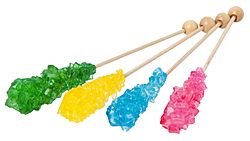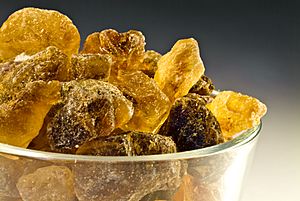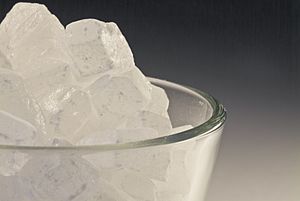Rock candy facts for kids

Colored and flavored rock candy commonly sold in the United States
|
|
| Alternative names | Rock sugar |
|---|---|
| Type | Confectionery |
| Main ingredients | Sugar, water |
| Variations | About 10 |
| 223–400 kcal | |
| Other information | 450–225 |
Rock candy, also known as rock sugar or crystal sugar, is a sweet treat made of large sugar crystals. It's a type of candy. This candy is created by letting a special sugar-water mix form crystals. The sugar crystals grow on a surface like a string, a stick, or even tiny sugar grains.
To make bigger crystals, the water is heated before adding the sugar. This helps more sugar dissolve. The crystals usually take about 6 to 7 days to form. You can also add Food coloring to the mix to make colorful rock candy.
Contents
What is Rock Candy Called?
The name "sugar candy" comes from old English words. It first meant "crystallized sugar." Later, especially in the United States, "candy" grew to mean any sweet treat made mostly from sugar. In Britain, these sweets are called "sweets," and "candy" often means boiled sugar sweets with bright stripes.
The American term "rock candy" describes the large, hard sugar crystals. It's different from the British "rock" candy, which is a boiled sugar product that starts hard but gets chewy.
How Rock Candy Started
People in Islamic countries wrote about making candy sugar as early as the 9th century. They described growing sugar crystals by cooling special sugar solutions. One famous maker of rock candy was Hafiz Mustafa, who started his business in Istanbul in 1864.
Rock sugar is made in two main ways. It can be single crystal rock sugar, meaning one large crystal. Or it can be polycrystalline rock sugar, which means many small crystals joined together.
Rock Candy in Food Around the World
Rock candy is often dissolved in tea. It's a big part of the tea culture in East Frisia, where a piece of rock sugar is put at the bottom of the cup. In Iran, drinking tea with rock candy, called nabat, is very popular. The most liked nabat has saffron in it. This way of drinking tea is also found in Central Asia, where it's called novvot.
It's a common ingredient in Chinese cooking. In China, it's used to sweeten chrysanthemum tea and Cantonese dessert soups. It's also added to the liquor baijiu. Many families use rock candy to marinate meats, add to stir-fries, and prepare special foods like yao shan. Long ago, rock sugar was a luxury only for rich people. Some people in China also believe rock candy has healing properties and use it in traditional Chinese medicine.
In Mexico, rock candy is used to make sugar skulls for the Day of the Dead. These skulls are often brightly decorated. Sugar skulls are given to children to help them not be afraid of death. They are also offered to honor those who have passed away.
In the Friesland province of the Netherlands, small pieces of rock candy are baked into a special white bread called Fryske Sûkerbôle.
Rock candy is also a common ingredient in Tamil cuisine, especially in the city of Jaffna in Sri Lanka.
In the United States, rock candy comes in many colors and flavors. It can be a bit hard to find because some people think of it as an old-fashioned candy.
Misri: Indian Rock Candy

Misri crystals
|
|
| Type | Rock candy or sweetener |
|---|---|
| Place of origin | India and Iran |
Misri is a type of crystallized sugar lump. It's a sweet mineral that comes from India and Iran. It's also known as rock sugar in other places. In India, people eat misri as a candy or use it to sweeten milk or tea.
In Hinduism, misri is sometimes offered to gods as bhog. It is then shared with people as prasad. The god Krishna is said to love makkhan (butter) and misri. Many devotional songs about Krishna often mention makkhan and misri together. In Karnataka, people offer misri with water to visitors during the summer.
Some Indian dishes made with misri include mishri-mawa (kalakand) and mishri-peda. These are popular in many parts of India, like Northern-Western India, Uttar Pradesh, Delhi, Rajasthan, Punjab, Odisha, Gujarat, and North coastal Andhra Pradesh.
The Ghantewala Halwai of Delhi, a famous sweet shop, started selling Misari mawa in 1790. They are known for their Misari mawa and make 40 different kinds of sweets using Misari.
Rock Candy in Drinks
"Rock and rye" is a name for both alcoholic drinks and non-alcoholic sodas. The alcoholic versions use rye whiskey and rock candy. Non-alcoholic versions, like the "Rock & Rye" soda pop by Faygo, taste similar but don't have alcohol.
Images for kids
See also
 In Spanish: Azúcar piedra para niños
In Spanish: Azúcar piedra para niños





